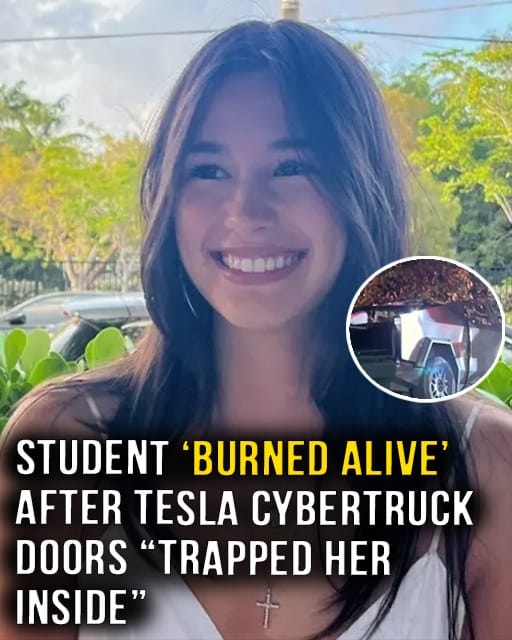The truck slammed into a concrete retaining wall just off the I-580 near Oakland. Within seconds, it burst into flames. Driver Soren Dixon (19) and passenger Jack Nelson (20) were killed instantly. Krysta Tsukahara (19), sitting in the rear seat, survived the impact — but not the fire.
Only one passenger, Jordan Miller, escaped. A friend following behind managed to smash the truck’s window with a broken branch, pulling Miller out moments before the entire vehicle was engulfed. By the time firefighters arrived, the Cybertruck was a steel skeleton.
Toxicology Reports and Harsh Realities
Later toxicology results revealed that Dixon had been driving under the influence — methamphetamine, cocaine, and a blood alcohol level more than double the legal limit. Both Tsukahara and Nelson also had alcohol and traces of cocaine in their systems.
Those findings made the tragedy harder to process but didn’t erase the question haunting the families: Why couldn’t she get out?
“She Couldn’t Get Out”
According to a wrongful-death lawsuit filed by Krysta’s parents, she survived the crash itself but died trapped inside as smoke and flames filled the cabin. The Cybertruck’s electrical system had failed, locking the powered doors. The car’s manual release, the family argues, was hidden, poorly labeled, and nearly impossible to access in the dark.
“Krysta tried to crawl through the passenger window while a friend outside was smashing the glass,” the filing states. “But as the heat intensified and the system shut down, she was forced back by the flames.”
Family attorney Roger Dreyer told reporters:
“This was a preventable death. Tesla knew the risks of its electronic-only door system yet failed to provide an intuitive manual override. When seconds mattered most, the car became a coffin.”
A Family’s Anguish
Krysta’s father, Carl Tsukahara, described his daughter as “bright, kind, and endlessly creative.” He said she loved photography and had just started college with dreams of working in environmental design.
“What breaks us most,” he said in a statement, “is not just losing her — it’s knowing she was alive after the crash, calling for help. She just couldn’t get out. How does a trillion-dollar company sell something that traps people in a fire?”
Both the Tsukahara and Nelson families have filed lawsuits against Tesla and the estate of the vehicle’s owner. They allege “gross negligence and conscious disregard for consumer safety.”
Their suits cite prior incidents where Tesla’s electronic door systems failed in emergencies, and claim the company ignored repeated warnings from regulators and engineers.
The Question of Accountability
Authorities confirmed that impaired driving and excessive speed caused the crash. Yet the families’ attorneys maintain that Tesla still bears responsibility for the fatalities.
“Driver error caused the impact,” Dreyer said, “but Tesla designed a vehicle that turned an accident survivable in most cars into a death sentence. Safety shouldn’t depend on perfect behavior — it should anticipate human error.”
Experts agree. Dr. Laura Park, a mechanical engineer specializing in automotive safety systems, explained:
“In emergency scenarios, redundancy is everything. Electronic systems can fail during crashes, so mechanical overrides must be simple and intuitive. Tesla’s minimalist design sacrifices that clarity.”
A Pattern of Problems
Since its hyped launch in late 2023, the Tesla Cybertruck has faced a series of recalls and public scrutiny. Issues range from braking malfunctions to spontaneous software shutdowns and even malfunctioning door locks.
Critics argue that Tesla’s obsession with minimalism and futuristic design often overlooks the practicalities of real-world emergencies. The Cybertruck’s heavy stainless-steel frame, for instance, makes it nearly indestructible from the outside — but also notoriously difficult to breach once sealed.
First responders have publicly voiced concerns. “These trucks are tanks,” said one California firefighter who attended the crash. “When they catch fire, you can’t get in, and you can’t put it out fast enough.”
When Innovation Outpaces Safety
Tesla built its empire on the promise of progress — sleek automation, AI-driven features, and vehicles that redefine transportation. But as cars become more like computers, they also inherit a computer’s fragility. One power surge, one short circuit, and every system — doors, windows, even seat adjustments — can fail simultaneously.
Industry analysts note that traditional automakers design with redundancy in mind: clear manual latches, visible release levers, and physical keyholes. Tesla, however, has eliminated most of these in the name of aesthetic minimalism and “user experience.”
“Technology should make us safer, not helpless,” said Park. “When people die because they can’t find a hidden lever, that’s not innovation — that’s negligence.”
Grief Turned Into a Mission
For Krysta’s parents, grief has become advocacy. They’ve begun working with safety organizations to push for new legislation requiring all electronic vehicles to have visible, standardized manual door releases. Their goal isn’t vengeance — it’s prevention.
“We can’t bring Krysta back,” her mother said, “but if one more person escapes because of what happened to her, then she hasn’t died in vain.”
Reflection: The Human Cost of “Progress”
This tragedy isn’t just about one crash or one company. It’s about the growing gap between technological advancement and human-centered design. As cars become smarter, faster, and more autonomous, they risk forgetting the most fundamental principle of engineering: protect life first.
Three young people are gone — their futures erased in seconds not just by recklessness, but by design flaws buried beneath the sheen of innovation.
When a car becomes too advanced for its passengers to escape, progress stops being progress. It becomes hubris.
The Final Lesson
The wreckage of that Cybertruck now sits in a California impound lot — a mangled monument to the cost of overlooking the obvious. For the families of Krysta Tsukahara, Jack Nelson, and Soren Dixon, justice will take time. But their message is already echoing through courtrooms and boardrooms alike:
Innovation means nothing if it can’t protect the people inside.

